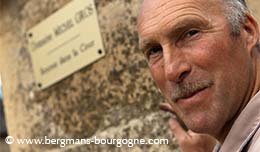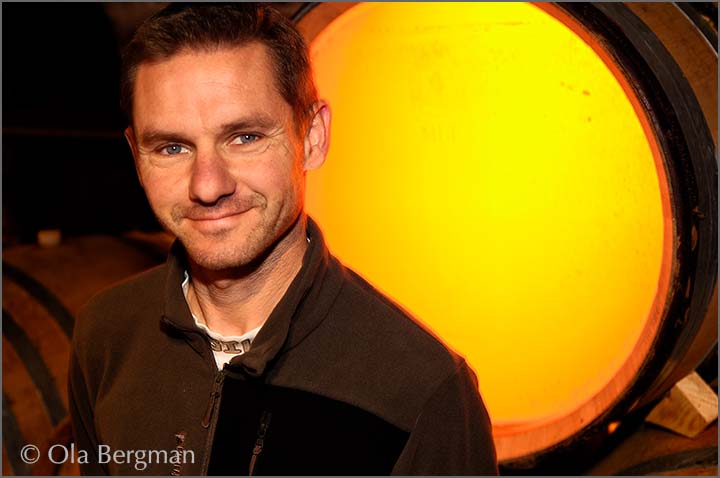
elcome to the white world of Stéphane Aladame. For the past two decades he has specialised in one single thing – Montagny premier cru.
– In short, Montagny could be summed up like this - we only have one colour, white. There is a large number of premier crus and the appellation is dominated by the local cooperative, which accounts for three quarters of the production, he says.
It was in 1992 that Domaine Stéphane Aladame saw the light of day in Montagny-lès-Buxy, the southern end of the Côte Chalonnaise. His plans for the future did not involve a domaine of his own, but fate had other things in store for the then 18 year old Aladame. Coming from a family not involved in wine production he did not have any vines of his own. So when Maxime Millet in Montagny-lès-Buxy decided to retire and offered Stéphane Aladame to rent his close to three hectares of vines it was an opportunity too good to be missed.
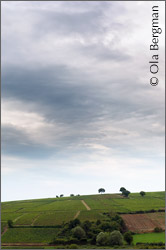 – When I started at the wine school in Beaune it was because I wanted to work in the vineyards. I wanted to be involved in winemaking, but not necessarily making my own wine. So to be able to take on a small domaine was a great thing for me. I bought some second-hand equipment and since then the domaine has grown slowly. I replanted a lot and today I have close to eight hectares.
– When I started at the wine school in Beaune it was because I wanted to work in the vineyards. I wanted to be involved in winemaking, but not necessarily making my own wine. So to be able to take on a small domaine was a great thing for me. I bought some second-hand equipment and since then the domaine has grown slowly. I replanted a lot and today I have close to eight hectares.
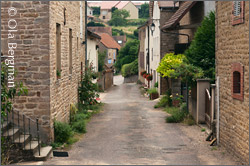 Stéphane Aladame has a strong focus on Montagny premier cru. He does not have any Montagny village vines. The only other wine he produces is the sparkling Crémant de Bourgogne. In 2005 he produced as much as nine different Montagny premier crus. Since then he has made some changes. Now there are six different bottlings of Montagny premier cru. Two of them – the Sélection Vieilles Vignes and the Découverte – are blends consisting of several different premier crus. The remaining four are separate premier crus – Les Burnins, Les Coères, Les Maroques and Les Vignes Derrière.
Stéphane Aladame has a strong focus on Montagny premier cru. He does not have any Montagny village vines. The only other wine he produces is the sparkling Crémant de Bourgogne. In 2005 he produced as much as nine different Montagny premier crus. Since then he has made some changes. Now there are six different bottlings of Montagny premier cru. Two of them – the Sélection Vieilles Vignes and the Découverte – are blends consisting of several different premier crus. The remaining four are separate premier crus – Les Burnins, Les Coères, Les Maroques and Les Vignes Derrière.
– From 2001 to 2009 I also bought in must from the premier cru Le Vieux Château, because I think it is an interesting climat. It is the most calcareous part of Montagny. But the parcels has been replanted, so I have not been able to continue with this wine, explains Stéphane Aladame.
– The cuvée Découverte comes from vines younger than 20 years, he continues. It never sees any wood. It is a blend of several premier crus and it is a cuvée that opens up quite quickly.
– Then there is the Sélection Vieilles Vignes, a cuvée from old vines. It comes from four different parcels, between 40 and 80 years old, in Les Platières, Les Las, Les Gouresses and Les Maroques. For the vinification I use barrels for half of the cuvée. Only ten per cent of the whole cuvée sees new oak.
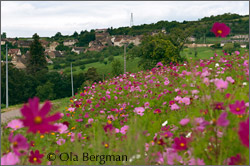 Almost half of the land holdings of the domaine are located in the premier cru of Les Maroques. Several parcels here give a total of three and a half hectares. The grapes from the young vines end up in the Découverte cuvée, the grapes from the old vines in the Sélection Vieilles Vignes. The vines that are between 30 and 40 years old are destined for the separate bottling of Les Maroques.
Almost half of the land holdings of the domaine are located in the premier cru of Les Maroques. Several parcels here give a total of three and a half hectares. The grapes from the young vines end up in the Découverte cuvée, the grapes from the old vines in the Sélection Vieilles Vignes. The vines that are between 30 and 40 years old are destined for the separate bottling of Les Maroques.
– In terms of vinification I treat Les Maroques quite similar to the Sélection Vieilles Vignes, with part of the cuvée in barrels. Les Vignes Derrière has younger vines, about 15 years old and farmed organically. Here I use no new oak at all. The vinification is the same for Les Coères. All in barrels, but no new oak.
Only part of Domaine Stéphane Aladame is worked organically. Certification of the domaine is not necessarily a goal in itself. Stéphane Aladame wants to take his time and evaluate.
 His Les Burnins, a premier cru located right east of Montagny-lès-Buxy comes from vines planted in 1923.
His Les Burnins, a premier cru located right east of Montagny-lès-Buxy comes from vines planted in 1923.
– It's planted with chardonnay muscaté. It's a clone of chardonnay – number 809 – which produces a touch of muscat in the taste. The soil in Les Burnins is more calcareous, but in this case the fact that it is chardonnay muscaté is more important for the taste than the soil.
The Montagny appellation dates back to 1936. There are as many as 51 different premier crus, but only a part of them are regularly seen on labels.
– There is a historical explanation for the large number of premier crus, says Stéphane Aladame. Up until 1990 there was just one single appellation for Montagny. There was no difference between premier cru land and village land. What was important was the minimum degree of alcohol. That decided whether it would be a Montagny village or a Montagny premier cru. So there was a lot of premier cru, about 80 per cent of the total production at the time. Then 1990 there was a reclassification made by the INAO, with separate areas for premier cru and village vines.
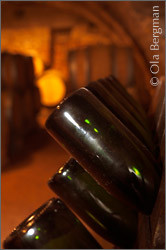 Since the appellation traditionally had produced much premier cru this was something that the INAO took into account when making the new classification. Of the 450 hectares of Montagny land 250 are classified as premier cru. Today only 300 hectares are under vines and well over 200 of these are premier cru.
Since the appellation traditionally had produced much premier cru this was something that the INAO took into account when making the new classification. Of the 450 hectares of Montagny land 250 are classified as premier cru. Today only 300 hectares are under vines and well over 200 of these are premier cru.
– The appellation has developed a lot over the years, says Stéphane Aladame. Even before Montagny received its appellation it was known for its white wines. Then it was sold to Beaune or Meursault. During the 1950's and the 1960's the situation became more difficult. The appellation was not particularly well-known, so the wines were difficult to sell.
At this time much of the appellation was planted with gamay. With mining towns like Le Creusot and Montceau-les-Mines nearby there was big demand for red wine.
 – So late 1970's/early1980's only 80-90 hectares of the Montagny appellation were under vines, says Stéphane Aladame. Since then a lot has been planted, so there is a large part of the Montagny vignoble that is quite young, younger than 30 years.
– So late 1970's/early1980's only 80-90 hectares of the Montagny appellation were under vines, says Stéphane Aladame. Since then a lot has been planted, so there is a large part of the Montagny vignoble that is quite young, younger than 30 years.
– Today Montagny is slightly less known than the other appellations on the Côte Chalonnaise. Being few producers – five in the village of Montagny-lès-Buxy and 18 in total – and with relatively small quantities produced does make things a bit more difficult. The cooperative in Buxy accounts for three quarters of the total production of the appellation.
– If you compare Montagny with Rully I would say that our wines in general are more mineral. This is because of our soil, which is more calcareous. In terms of subsoil we are perhaps closer to Chablis. Also, the use of oak is more limited in Montagny. You could say that we are more Chablis than Côte d'Or.
© 2012 Ola Bergman










